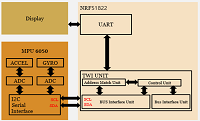Stretchable, Patch-Type, Wireless, 6-axis Inertial Measurement Unit for Mobile Health Monitoring
DOI:
https://doi.org/10.46604/peti.2020.4272Keywords:
Bluetooth low energy (BLE), inertial measurement unit (IMU), epidermal electronics, serpentine-shaped interconnectionAbstract
Wearable devices which measure and transfer signals from the human body can provide useful biometric data for various biomedical applications. In this paper, we present an implementation of the advanced Inertial Measurement Unit (IMU) with wireless communication technology for mobile health monitoring. The device consists of rigid silicon-based components on a flexible/stretchable substrate for applications in epidermal electronic devices to collect precise data from the human body. Using the Bluetooth Low Energy (BLE) System-on-a-chip (SoC), the device can be miniaturized and portable, and the collected data can be processed with low power consumption. The dimensions of the implemented system are approximately 40 mm × 40 mm × 100 mm. Also, the device can be attached closely to human skin, which results in minimized signal distortion due to body movements or skin deformations. In order to achieve device flexibility and stretch ability, the interconnection wires are designed as serpentine-shaped structures on a stretchable substrate. The previously reported “cut-and-paste” method is utilized to fabricate the device that produces complex, twisty interconnections with thin metal sheets. The implemented patch-type, wireless, 6-axis IMU is expected to have potential in various applications, such as health monitoring, dependency care, and daily lifelogging.
References
D. Kim, N. Lu, R. Ma, Y. Kim, R. Kim, S. Wang, et al., “Epidermal electronics,” Science, vol. 333, no. 6044, pp. 838-843, August 2011.
H. Lee, T. K. Choi, Y. B. Lee, H. R. Cho, R. Ghaffari, L. Wang, et al., “A graphene-based electrochemical device with thermoresponsive microneedles for diabetes monitoring and therapy,” Nature Nanotechnology, vol. 11, no. 6, pp. 566-572, 2016.
A. Miyamoto, S. Lee, N. F. Cooray, S. Lee, M. Mori, N. Matsuhisa, et al., “Inflammation-free, gas-permeable, lightweight, stretchable on-skin electronics with nanomeshes,” Nature Nanotechnology, vol. 12, no. 9, pp. 907-913, 2017.
P. Salvo, A. Pingitore, A. Barbini, and F. Di Francesco, “A wearable sweat rate sensor to monitor the athletes’ performance during training,” Science & Sports, vol. 33, no. 2, pp. e51-e58, October 2017.
W. Gao, H. Ota, D. Kiriya, K. Takei, and A. Javey, “Flexible electronics toward wearable sensing,” Accounts of Chemical Research, vol. 52, no. 3, pp. 523-533, 2019.
Y. Liu, J. J. S. Norton, R. Qazi, Z. Zou, K. R. Ammann, H. Liu, et al., “Epidermal mechano-acoustic sensing electronics for cardiovascular diagnostics and human-machine interfaces,” Science Advances, vol. 2, no. 11, pp. e1601185, November 2016.
S. Huang, Y. Liu, Y. Zhao, Z. Ren, and C. F. Guo, “Flexible electronics: stretchable electrodes and their future,” Advanced Functional Materials, vol. 29, no. 6, pp. 1805924, 2019.
S. Lim, D. Son, J. Kim, Y. B. Lee, J. Song, S. Choi, et al., “Wearable electronics: transparent and stretchable interactive human machine interface based on patterned graphene heterostructures,” Advanced Functional Materials, vol. 25, no. 3, pp. 375-383, November 2014.
M. Kaltenbrunner, T. Sekitani, J. Reeder, T. Yokota, K. Kuribara, T. Tokuhara, et al., “An ultra-lightweight design for imperceptible plastic electronics,” Nature, vol. 499, no. 7459, pp. 458-463, July 2013.
Q. Cao, H. S. Kim, N. Pimparkar, J. P. Kulkarni, C. Wang, M. Shim, et al., “Medium-scale carbon nanotube thin-film integrated circuits on flexible plastic substrates,” Nature, vol. 454, no. 7203, pp. 495-500, July 2008.
B. Crone, A. Dodabalapur, Y. Y. Lin, R. Filas, Z. Bao, A. LaDuca, et al., “Large-scale complementary integrated circuits based on organic transistors,” Nature, vol. 403, no. 6769, pp. 521-523, 2000.
W. Teufl, M. Lorenz, M. Miezal, B. Taetz, M. Frohlich, and G. Bleser, “Towards inertial sensor based mobile gait analysis: event-detection and spatio-temporal parameters,” Sensors, vol. 19, no. 1, pp. 38, 2019.

Published
How to Cite
Issue
Section
License
Submission of a manuscript implies: that the work described has not been published before that it is not under consideration for publication elsewhere; that if and when the manuscript is accepted for publication. Authors can retain copyright of their article with no restrictions. Also, author can post the final, peer-reviewed manuscript version (postprint) to any repository or website.

Since Oct. 01, 2015, PETI will publish new articles with Creative Commons Attribution Non-Commercial License, under The Creative Commons Attribution Non-Commercial 4.0 International (CC BY-NC 4.0) License.
The Creative Commons Attribution Non-Commercial (CC-BY-NC) License permits use, distribution and reproduction in any medium, provided the original work is properly cited and is not used for commercial purposes







